Football/Soccer Session (Academy Sessions): Defending the attack

Profile Summary

| Name: | Mark Smith |
|---|---|
| City: | Llanelli |
| Country: | United Kingdom |
| Membership: | Adult Member |
| Sport: | Football/Soccer |
Description
SET UP
- Full half
- 2 mini goals across the half way line
- Flat markers across pitch to mark final 3rd
- 1 main goal
- Balls in the middle of the pitch
- Start from opposition CDM or coach
- Lead coach throw ball in sporadically to encourage transition
- Red counter to mini goals, blue attack main goal
- 3 x 5mins
- 2min rest
- Red - 2 points scoring in mini goal
- Blue - 1 point for a goal
- Red have 10 seconds to score after turnover of possession
DEFENDING 7 (4-2-3-1 No Attacking Players) v 8 ATTACKING (4-3-3 No CB'S)
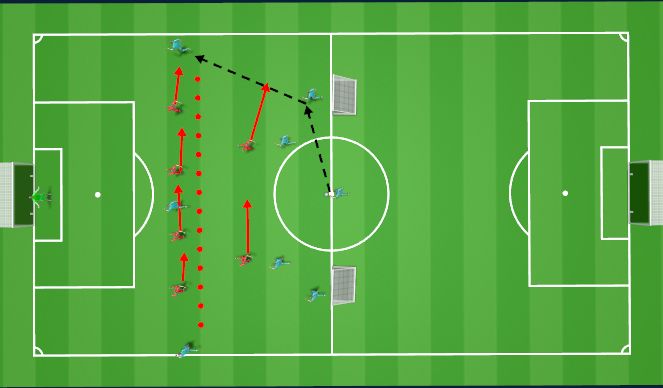
See the guidance at the top of this page to understand why you are not seeing interactive Football/Soccer images.

Solution: Defending Wide Overloads
Compact Defensive Shape
- Full-Back Positioning: Ensure the red full-backs stay close to the CB's, not getting dragged too wide too early. This will help maintain a compact back line and prevent gaps.
- Shift as a Unit: When the ball is shifted wide by the blues, the entire defensive unit (back four and two CDMs) should shuffle across, staying compact and blocking central passing options.
Support from CDMs
- The two CDMs should offer cover for the full-backs. One CDM can shift to help double up on the winger if a wide overload is occurring, while the other CDM stays central to protect against any cutbacks or late runners into the box.
- Communication between the full-back and the nearest CDM is crucial to ensure that no player is isolated.
Forcing Play Outside
- Encourage the defenders to show the blue attackers down the line instead of allowing them to cut inside. By forcing the blues to cross from deeper or less dangerous positions, it minimises the threat of a more central or close-range attack.
Pressuring the Ball Early
- In wide areas, press the ball carrier aggressively to prevent the cross or forward pass. The full-back should engage early with support from the CDM, while the CB's stay ready to defend the cross.
Tracking Runners
- Both the full-back and the nearest CDM need to track any overlapping or underlapping runs made by the blues' wide players. This is critical to prevent overloads leading to unmarked players in dangerous positions.
Dealing with Crosses
- CB's and the goalkeeper should be prepared to deal with crosses. CB's need to be dominant in the air and proactive in clearing crosses, while the goalkeeper can command the box and either catch or punch clear.
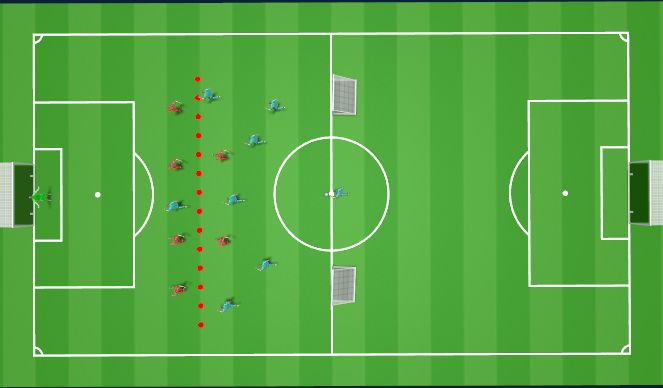
See the guidance at the top of this page to understand why you are not seeing interactive Football/Soccer images.

Problem no. 2: Defending Central Overload
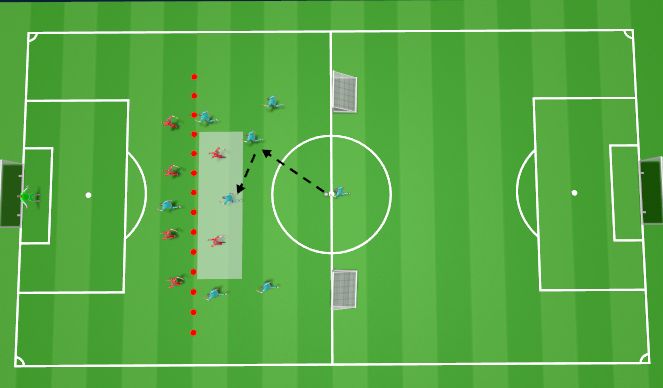
See the guidance at the top of this page to understand why you are not seeing interactive Football/Soccer images.

Solution: Defending Central Overloads
Compact Defensive Shape
- Narrow the Back 4: The red back four needs to stay narrow and compact, ensuring that there are no gaps between the CB's and the full-backs for the blue attackers to exploit.
- CDMs Screening the Back 4: Both CDMs must sit just in front of the back line, forming a protective screen to cut off passing lanes into the blue attackers. They must stay disciplined, not chasing the ball too high up the pitch, and instead, they should prioritise blocking central spaces.
Cutting Off Passing Lanes
- Positioning of CDMs: The two CDMs should take up positions where they can block passing lanes into the blue attackers in central areas. Their goal is to prevent the ball from reaching the blue strikers or midfielders between the lines.
- Cover Shadows: Encourage the CDMs to move in ways that cut off more than one passing option at a time, using their body position to block potential routes into the central areas while also being ready to step in to win the ball.
Pressing the Ball
- When the ball is in central areas, the nearest CDM or CB's should step out to apply pressure. The timing of this press is crucial; they should go when there's an opportunity to either intercept or force the ball backward.
- The remaining CDM and CB's must be aware and ready to cover the space left behind the pressing player, so there are no gaps for the blues to exploit with a through ball.
Staying Compact and Disciplined
- No Stepping Out Too Early: Discourage defenders and CDMs from stepping out of position to press unless the timing is perfect. Blues will often look to lure one of the defenders out to create gaps. It's crucial that reds maintain their shape and discipline, forcing the blues to play wide or take risky passes.
- Blocking Shots and Passing Lanes: Encourage the defensive line and CDMs to position themselves to block shots or quick one-two combinations through the centre.
Tracking Runners
- Blue midfielders and forwards will likely try to make off-the-ball runs into space between the lines. The CB's and CDMs must stay alert to these movements, tracking any late runners or midfielders trying to overload the central areas.
- Communication between CB's and CDMs is crucial to ensure that runners aren’t left unmarked.
Defending Forward Passes
- Force the blue team to play backward or sideways by applying pressure in central areas and denying vertical passing lanes. This will slow down the blues’ attack and force them to seek wide options, where they are less dangerous.
Defensive Responsibilities:
- Centre-Backs: Stay tight and compact, ready to clear any through balls or crosses into the central area.
- CDMs: Constantly block central passing lanes and press when appropriate, staying ready to intercept or disrupt combinations.
- Full-Backs: Stay tucked in close to the CB's when the play is central, ensuring there are no gaps between them and the nearest CB's. They should only step out when the ball moves wide.
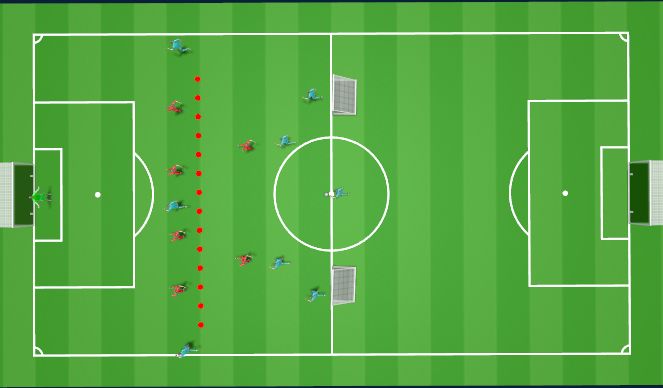
See the guidance at the top of this page to understand why you are not seeing interactive Football/Soccer images.

Problem no. 3: Managing Transitions from Defence to Attack
The reds need to defend central overloads while staying organised, but the focus shifts toward what happens after they win possession. Quick and intelligent decisions are needed to exploit the spaces left by the blues when they commit numbers forward centrally. Reds must be able to transition rapidly from a defensive phase to an attacking one.
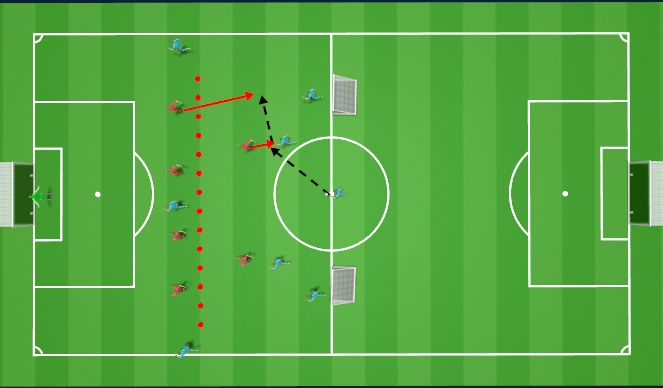
See the guidance at the top of this page to understand why you are not seeing interactive Football/Soccer images.

Solution: Managing Transitions Effectively
Anticipate the Transition
- Midfield Awareness: Both the red CDMs need to be constantly aware of how the game is developing. When they win the ball, they must know their next action. This could be playing a forward pass, carrying the ball into space, or recycling possession to relieve pressure. Their first instinct should be to scan for forward options.
Fast Forward Passes
- Once possession is won, the ball should be moved forward quickly to exploit the spaces left by the blues, who are likely caught high up the pitch. Encourage fast, vertical passes from the CDMs or CB'S to the wide players or striker. These passes should bypass the blue midfield and put your team immediately on the front foot.
Using the Wide Players
- The wide areas will likely be underused by the blues as they focus on central overloads. Exploit this by instructing your wide players full-backs to push forward quickly when the ball is recovered. A quick switch of play to the wings can stretch the blue defence and create dangerous attacking opportunities.
- Encourage full-backs to get involved in the attack during transitions. They should overlap the wingers, providing width and forcing the blue defenders to chase back.
Counterattacking Play
- Exploit the Space: When the blues lose possession in central areas, they will likely leave space behind their full-backs or in front of their back three. The red full backs or central player should be ready to make runs into this space as soon as the ball is won.
- Directness: Encourage a direct approach to counterattacks. Focus on fast, purposeful forward movement. The players need to move the ball with speed and attack the goal quickly before the blues can recover into defensive positions.
Switching Play
- If the central areas are congested and the blue team quickly closes down space, look to switch the play to the opposite side where there will be more room. CDMs and CB's need to be aware of the space on the far side and shift the ball quickly to the wingers or overlapping full-backs to exploit it.








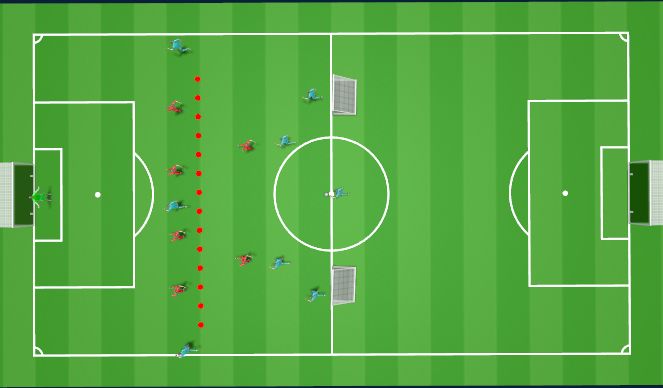
 Play animation
Play animation Play step-by-step
Play step-by-step Repeat (toggle)
Repeat (toggle) Full Screen
Full Screen Pause
Pause Stop
Stop
Problem: Defending the Wide Overload (25 mins)
The blue team will likely attempt to overload the wide areas by bringing their wing-backs or wingers into advanced positions. This could leave the red full-backs exposed in 1v2 or 2v3 situations.